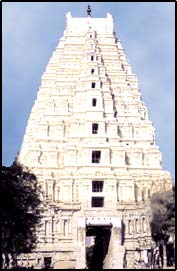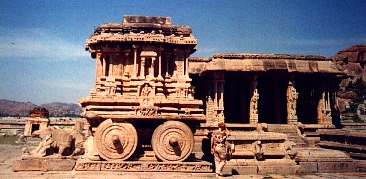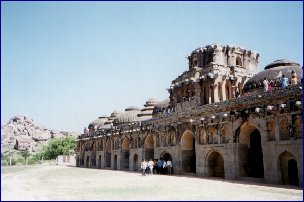The Vijayanagar city ruins near the village of Hampi
are one of the most fascinating historical sites in south India. The
superb ruins are set in a strange and beautiful landscape which has an
almost magical quality – a hill country that is partly desolated and
strewn with enormous, rounded boulders, and partly irrigated and
cultivated. The Tungabhadra River runs along the northern edge of this
large area.
The best way to soak up the atmosphere here is to spend several
days and take your time exploring the area, though it is possible to see
all the main sites in one day on foot if you start early. Signposting on
the site is somewhat inadequate and the trails sometimes indistinct, but
you can’t really get lost. It may be best not to wander around the sites
alone, especially at dawn or dusk when it’s relatively dark, as there
have been a couple of muggings here in recently years.
Hampi
Bazaar
 The old Hampi Bazaar is now a bustling village, and
the locals (and their animals) have inhabited the old bazaar buildings
which line the main street. The village has become something of a
travellers’ Mecca and it is superb place to stay if you’re not too
concerned about minor luxuries or the fact that diluted dung is spayed on
doorsteps every morning to keep the dust down and the rangolis
(chalk designs) looking fresh !
The old Hampi Bazaar is now a bustling village, and
the locals (and their animals) have inhabited the old bazaar buildings
which line the main street. The village has become something of a
travellers’ Mecca and it is superb place to stay if you’re not too
concerned about minor luxuries or the fact that diluted dung is spayed on
doorsteps every morning to keep the dust down and the rangolis
(chalk designs) looking fresh !
The western side of Hampi Bazaar is the most bustling area. Here
you’ll find a number of restaurants catering for Western travellers, the
Aspiration Stores which has a variety of books as well as souvenirs such
as handmade paper, and plenty of soft-drink and trinket stalls.
The village is dominated by the Virupaksha
Temple with its 52-metre-high gopuram, those structures which typify
temples in Tamil Nadu. The temple dates back to the middle of the 15th
century and is popular with Indian tourist.
Vittala
Temple
 From the far end of Hampi Bazaar an obvious track
leads left to the highlight of the ruins, the Vittala Temple, some two km
away. This temple is a World Heritage Monuments (one of only three in
south India, the others being at Thanjavur and Mahabalipuram in Tamil Nadu)
and is in a good state of preservation, though purists may well have
reservations about the cement-block columns which have been erected to
keep the main structure from falling down. Although it was never finished
or consecrated, the incredible sculptural work of the Vittala Temple is of
the highest standard and is the pinnacle of Vijayanagar art. The outer
pillars are known as the musical pillars as they reverberate when tapped,
although this practice is being actively discouraged as the pillars are
somewhat the worse for wear. The stone chariot or cart in front of the
temple is one of the most photographed objects in this part of India; the
wheels even used to turn!
From the far end of Hampi Bazaar an obvious track
leads left to the highlight of the ruins, the Vittala Temple, some two km
away. This temple is a World Heritage Monuments (one of only three in
south India, the others being at Thanjavur and Mahabalipuram in Tamil Nadu)
and is in a good state of preservation, though purists may well have
reservations about the cement-block columns which have been erected to
keep the main structure from falling down. Although it was never finished
or consecrated, the incredible sculptural work of the Vittala Temple is of
the highest standard and is the pinnacle of Vijayanagar art. The outer
pillars are known as the musical pillars as they reverberate when tapped,
although this practice is being actively discouraged as the pillars are
somewhat the worse for wear. The stone chariot or cart in front of the
temple is one of the most photographed objects in this part of India; the
wheels even used to turn!
Sule
Bazaar & Achyutaraya Temple
Halfway from Hampi Bazaar to the Vittala Temple but
off to the right, is the deserted Sule Bazaar, which gives you some idea
of what Hampi Bazaar might have looked like if it hadn’t been
repopulated. At the southern if it hadn’t been repopulated. At the
southern end of this area is the Achyutaraya Temple which, if anything, is
even more atmospheric than the Vittala Temple since there’s rarely
anyone there and the carvings are just as fine.
Royal
Enclosure Area
This area of Hampi is quite different from the
northern section in that there are nowhere near as many rounded boulders
littering the site- most have been used to make a mind- boggling
proliferation of beautifully executed stone walls.
It is quite a walk (about two km) from the
Achyutaraya Temple to the Royal Enclosure area, and you need to have wits
about you otherwise you could get lost (though not drastically). Leaving
the rear (southern end) of Achyutaraya Temple, take the path which passes
alongside a small shrine under a huge, old, gnarled tree and then turn
right along-side a small shrine under a huge, old, gnarled tree and then
turn right alongside an irrigation ditch and overlooking a field below.
Continue along this, crossing over three further irrigation ditches to the
valley bottom and then up the far side until you come to the fourth (and
largest) irrigation channel (which always has water in it) beside a small,
part –ruined Siva temple (there’s no Siva image anymore but the Nandi
is still there).
Right opposite this temple is a stone bridge across the channel.
Cross this and head to the right. This will take you past another
(disused) temple after which you need to veer off to the right until you
get to the palace walls. The entrances through the walls, turn sharp left
and follow the gravel road until you get to the Royal Enclosure area.

Within various stone-walled enclosures here are the rest of
Hampi’s major attractions. First up are the Lotus
Mahal and the Elephant Stables.
The former is a delicately designed pavilion in a walled compound known as
the Zanana Enclosure. The building gets its name from the lotus bud carved
in the centre of the domed and vaulted ceiling. The Elephants Stables is a
grand building with eleven domed chambers for housing the state elephants.
Further south are the Royal Enclosure with its various temple, the Uderground Temple and the Queen’s
Bath.





